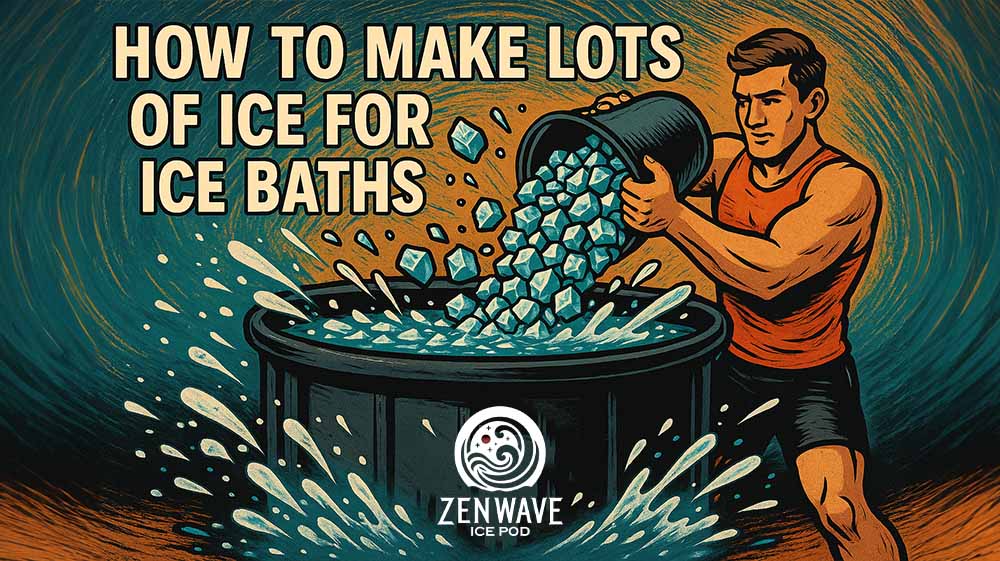Ice baths aren’t just cold—they’re logistically brutal. You need pounds of ice, and unless you live next to a frozen lake, that doesn’t happen by accident.
The hardest part isn’t the temperature shock or breathing through the discomfort. It’s the ice. Running to the gas station every other day, spending $15 on bags that melt in 30 minutes, or frantically filling ice cube trays at midnight because you forgot to prep.
Here’s what actually works—from freezing water bottles in your kitchen to commercial-grade ice machines that pump out hundreds of pounds daily.
How Much Ice Do You Need for an Ice Bath?
The standard recommendation is a 1:3 ice-to-water ratio by volume. For every 1 gallon of water, you need about 2.5–3 pounds of ice.
But that’s just the starting point. Your actual needs depend on:
- Tub Size: Larger tubs demand more ice
- Starting Water Temperature: Cold tap water needs less supplemental cooling
- Ambient Temperature: Hot summer days melt ice faster
- Session Length: Longer soaks = more melt = more ice needed
- Tub Insulation: Better insulation preserves your ice investment
- Target Temperature: Hitting 50°F requires more ice than settling for 59°F
We built an cold plunge ice quantity calculator that factors in most of these variables. Plug in your setup and get your exact ice requirements.
DIY Ice Methods That Actually Scale
How to Use Frozen Water Bottles or Gallons for Ice Baths
A simple, cost-effective method: freeze 1-gallon water jugs, juice bottles, or milk containers. Each gallon gives you 8+ lbs of slow-melting ice you can reuse again and again.
Spread them evenly in your tub for balanced cooling. Don’t forget to leave expansion space in each jug before freezing.
For organizing your plunge setup, check out our Ice Bath Prep Checklist.
Making Block Ice with Ice Cube Trays and Household Containers
Standard trays work, but think bigger. Use baking pans, silicone molds, Tupperware, or empty milk cartons to create block ice.
Bigger blocks melt slower and maintain temperature longer. Smaller ice cools the water quicker, but melts faster. Start freezing 2-3 days before your plunge to stockpile enough volume.
Using a Home Ice Maker for Regular Cold Plunges
A compact ice maker can produce 20–200 lbs/day, which is enough for many personal plunges. Look for machines with high-capacity bins and fast cycle times.
If you plunge multiple times a week, this is a smart long-term investment. Pair it with frozen bottles for a scalable setup.
Explore our top picks in the Best Ice Makers for Ice Baths roundup.
Buying Ice for Ice Baths: Quick Fix, Expensive Long-Term
Bagged Ice from Stores
Available everywhere—gas stations, grocery stores, convenience shops. Most bags contain 7-20 pounds.
The math gets ugly fast. At $3-5 per bag, daily ice baths cost $20-35 weekly just for ice. That’s $1,000+ annually.
Good for last-minute plunges or supplementing your DIY stash. Terrible for consistent routines.
Bulk Ice Delivery
Ice companies deliver hundreds of pounds to your door. Usually requires advance scheduling and truck access to your location.
Perfect for group sessions, athletic teams, or ice bath parties. Some services offer weekly deliveries for serious cold therapy practitioners.
High-Volume Ice Solutions for Home or Business Use
Commercial Ice Block Makers
These machines freeze water in large molds, producing massive blocks. Output ranges from 100-500 pounds daily.
Used by gyms, spas, wellness centers, and professional recovery facilities. The footprint is substantial and power consumption is high.
Flake Ice Machines
Produce soft, snow-like ice that spreads easily and chills water fast. Common in industrial kitchens and medical applications.
Flake ice provides immediate, even cooling throughout your tub. The texture conforms to your body better than solid blocks.
Downside: Expensive and overkill for most home setups.
How to Use a Water Chiller Instead of Ice
Instead of hauling ice daily, plug in a water chiller. These systems circulate and cool your plunge water automatically, maintaining set temperatures 24/7.
Why Choose a Water Chiller:
- Precision Cooling: Set exact target temperatures
- No Ice Required: Fully automated operation
- Long-Term Savings: High upfront cost, but no daily ice expenses
- Clean and Efficient: Built-in filtration extends water life
Drawbacks:
- Significant upfront investment ($800-3000+)
- Takes up space and requires electrical outlet near your tub
- Requires regular maintenance
Our guide to the best water chillers for ice baths breaks down our favorite models by price, performance, and installation requirements.
Method Comparison: What Works When
| Method | Daily Output | Cost | Convenience | Best For |
|---|---|---|---|---|
| Freeze bottles/containers | Low–Medium | Low | High | Beginners, budget builds |
| Ice trays/large containers | Low | Low | Medium | Occasional users |
| Home ice maker | Medium | Medium | High | Regular personal use |
| Bagged ice | Medium–High | High | Very High | Emergency sessions |
| Bulk ice delivery | High | High | High | Group plunges, teams |
| Commercial machines | Very High | Very High | Medium | Professional facilities |
| Water chiller (no ice) | N/A | Very High | Very High | Daily plungers |
Efficiency Hacks That Save Time and Money
- Start Early: Freeze over multiple days to build inventory. Don’t wait until plunge day.
- Use Larger Containers: Big blocks last longer than small cubes. Surface area matters.
- Label by Weight: Mark containers with ice weight (e.g., “20 lbs”) to plan sessions accurately.
- Combine Methods: Mix DIY frozen bottles with purchased ice for flexibility.
- Insulate Your Tub: Reduce melt rate with thermal covers or blankets around your container.
- Time Your Sessions: Plunge during cooler parts of the day to preserve ice longer.
Depending on how often you take ice baths, you may consider adding some ice the night before to help keep the water cooler. Want to use less ice? Understand what temperature your ice bath should be to stay within effective recovery zones.
How to Keep Your Ice Bath Water Clean
No matter how you source your ice, keeping your plunge water clean is just as important—especially if you’re reusing water or using a chiller system.
Here are three essential ways to keep your water fresh:
- Add Hydrogen Peroxide – A small dose helps control bacteria buildup. Learn the proper method in our guide on how to use hydrogen peroxide to keep your ice bath clean.
- Use a Water Chiller with Filtration – Most chillers come with built-in filters to help extend water life between cleanings.
- Install DIY Filtration – Want to build your own system? Follow our step-by-step DIY ice bath filtration guide.
For full breakdowns of how long your plunge water lasts before needing to be replaced, read how long does ice bath water last.
Final Thoughts: Building Your Ice System
Your ice strategy should match your commitment level:
- Casual Plungers (1-2x weekly): Frozen bottles + occasional bagged ice
- Regular Users (3-5x weekly): Home ice maker + backup bottles
- Daily Plungers: Water chiller or commercial ice machine
- Group/Team Use: Bulk delivery or high-output commercial unit
The key is consistency. Pick a method you can sustain without burning out on logistics.
Ice baths transform your nervous system resilience and recovery capacity. Don’t let ice logistics derail the amazing benefits that ice baths offer. Build a system that works, stick with it, and stay consistently cold.

